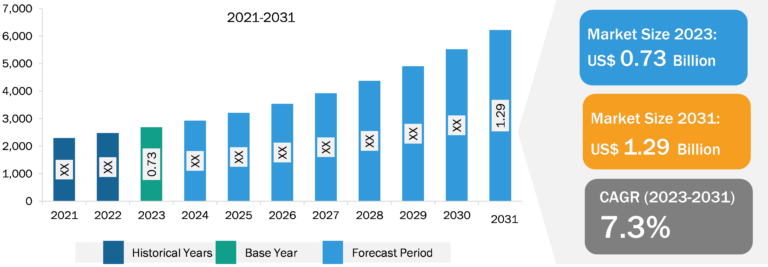
Pyranometer Market
The development of new materials and technologies can improve the performance of pyranometers. New types of sensors such as silicon-cell solar radiation sensor can be used to measure solar radiation more accurately, and new materials can make pyranometers more durable and resistant to harsh weather conditions. The use of silicon solar cells can provide a more accurate and consistent measurement of solar radiation. Many companies such as Apogee provide a silicon cell pyranometer. Apogee series pyranometers are silicon-cell pyranometers that are only sensitive to a portion of the solar spectrum, between 350 and 1,100 nm (~80% of total shortwave energy falls within this range). Also, the LightScout Silicon Pyranometer from Spectrum Technologies uses a silicon solar cell as the sensor. This sensor provides a more accurate and consistent solar radiation measurement than traditional thermopile pyranometers. The standards for developing silicon-cell pyranometers must meet the International Organisation of Standardization (ISO) 9060:2018 Class C requirements.
Further, new technologies to improve the overall performance and maintenance of pyranometers are being developed by various organizations across the globe. For instance, the SMP12 pyranometer from Kipp & Zonen uses solid-state dome heating, no moving systems, and best-in-class surge protection to maximize accuracy and reduce maintenance requirements. Such technological advancement in pyranometers will lead to more accurate, reliable, and affordable pyranometers for a wider range of applications. Thus, the growing focus on technological advancement related to pyranometers is expected to fuel the pyranometer market size during the forecast period.

A thermopile pyranometer or a thermo-electric pyranometer is a sensor based on thermopiles. It is designed to calculate the broadband of the solar radiation flux density, which varies from 180° field of view angle. With a largely flat spectral sensitivity, a thermopile pyranometer generally measures from 300 to 2,800 nm. In all thermopile technology, irradiation is proportional to the difference between the temperature of the shadow area and the sun-exposed area. In thermopile pyranometers, a thermopile is usually used within the instrument as the thermal gradient, and the sensor is measured across cold and hot areas (black and white). The accuracy depends upon the sensitivity of the material used in the sensors, the distortion characteristics, and the response time of the material constituting the dome (if present) covering the sensors.
A pyranometer is a radiometer designed to measure the irradiance (in W/m2) resulting from radiant fluxes on a plane surface from the hemisphere above and integrated over a wavelength range of at least 300 to 3,000 nm. Photovoltaic pyranometers are applied in solar simulators and photovoltaic systems to measure photovoltaic module effective power and system performance. It can also be utilized for preliminary findings of malfunction in photovoltaic systems, as a photovoltaic pyranometer’s response is the same as that of a photovoltaic module. Moreover, solar radiation is a great source of zero-emission renewable energy. High-quality, reliable radiation data is crucial in implementing all solar energy sector projects in photovoltaic (PV) and concentrating solar power (CSP) thermal systems.
Pyranometer Market: Segmental Overview
Based on type, the pyranometer market is bifurcated into:
- Photovoltaic Pyranometer
- Thermopile Pyranometer
The photovoltaic pyranometer segment held a larger pyranometer market share in 2022; and it is expected to record a higher CAGR in the pyranometer market during the forecast period.
Based on application, the pyranometer market is segmented into:
- Photovoltaic Systems
- Meteorology
- Climate Stations
Based on geography, the pyranometer market is segmented into:
- North America
- Europe
- Asia Pacific
- MEA
- SAM
The photovoltaic systems segment held the largest pyranometer market share in 2022; and it is expected to record the highest CAGR in the pyranometer market during the forecast period.
Pyranometer Market Analysis: Competitive Landscape and Key Developments
Hukseflux Thermal Sensors BV, Delta Ohm Srl, Li-Cor Inc, Eppley Laboratory Inc, OTT Hydromet Corp, Lambrecht Meteo Gmbh, Apogee Instruments Inc, Campbell Scientific Inc, Delta-T Devices Ltd, Eko Instruments Co Ltd Co Ltd, and Hoskin Scientific Ltd are a few of the major companies operating in the global pyranometer market. The market leaders in the global pyranometer market focus on new product launches, expansion and diversification, and acquisition strategies, which allow them to access prevailing business opportunities.
- In August 2022, The University of Michigan Solar Car Team achieved a remarkable achievement by completing a 3,000-mile journey across the US using EKO’s Class A MS-80S Pyranometers for precise irradiance measurements. This successful test of their solar vehicle—the Aevum—demonstrates the pivotal role of pyranometers in optimizing solar car performance and strategy, underscoring their significance in the renewable energy landscape.
- In February 2020, MOSAiC, the largest polar research expedition, selected Delta-T Devices’ SPN1 Sunshine Pyranometer to assess solar radiation in the Central Arctic. This choice highlights the SPN1’s reliability in extreme environments, requiring no adjustments during use. The pyranometer market witnessed increased demand for such robust instruments in climate change studies.






